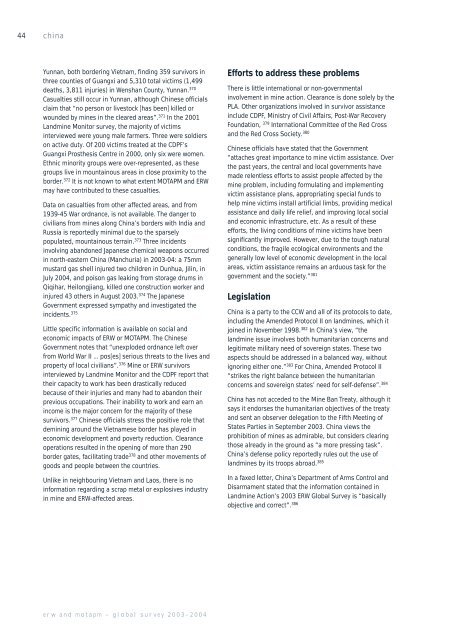Country & Territory Reports - Landmine Action
Country & Territory Reports - Landmine Action
Country & Territory Reports - Landmine Action
You also want an ePaper? Increase the reach of your titles
YUMPU automatically turns print PDFs into web optimized ePapers that Google loves.
44 china<br />
Yunnan, both bordering Vietnam, finding 359 survivors in<br />
three counties of Guangxi and 5,310 total victims (1,499<br />
deaths, 3,811 injuries) in Wenshan County, Yunnan. 370<br />
Casualties still occur in Yunnan, although Chinese officials<br />
claim that “no person or livestock [has been] killed or<br />
wounded by mines in the cleared areas”. 371 In the 2001<br />
<strong>Landmine</strong> Monitor survey, the majority of victims<br />
interviewed were young male farmers. Three were soldiers<br />
on active duty. Of 200 victims treated at the CDPF’s<br />
Guangxi Prosthesis Centre in 2000, only six were women.<br />
Ethnic minority groups were over-represented, as these<br />
groups live in mountainous areas in close proximity to the<br />
border. 372 It is not known to what extent MOTAPM and ERW<br />
may have contributed to these casualties.<br />
Data on casualties from other affected areas, and from<br />
1939-45 War ordnance, is not available. The danger to<br />
civilians from mines along China’s borders with India and<br />
Russia is reportedly minimal due to the sparsely<br />
populated, mountainous terrain. 373 Three incidents<br />
involving abandoned Japanese chemical weapons occurred<br />
in north-eastern China (Manchuria) in 2003-04: a 75mm<br />
mustard gas shell injured two children in Dunhua, Jilin, in<br />
July 2004, and poison gas leaking from storage drums in<br />
Qiqihar, Heilongjiang, killed one construction worker and<br />
injured 43 others in August 2003. 374 The Japanese<br />
Government expressed sympathy and investigated the<br />
incidents. 375<br />
Little specific information is available on social and<br />
economic impacts of ERW or MOTAPM. The Chinese<br />
Government notes that “unexploded ordnance left over<br />
from World War II … pos[es] serious threats to the lives and<br />
property of local civilians”. 376 Mine or ERW survivors<br />
interviewed by <strong>Landmine</strong> Monitor and the CDPF report that<br />
their capacity to work has been drastically reduced<br />
because of their injuries and many had to abandon their<br />
previous occupations. Their inability to work and earn an<br />
income is the major concern for the majority of these<br />
survivors. 377 Chinese officials stress the positive role that<br />
demining around the Vietnamese border has played in<br />
economic development and poverty reduction. Clearance<br />
operations resulted in the opening of more than 290<br />
border gates, facilitating trade 378 and other movements of<br />
goods and people between the countries.<br />
Unlike in neighbouring Vietnam and Laos, there is no<br />
information regarding a scrap metal or explosives industry<br />
in mine and ERW-affected areas.<br />
erw and motapm – global survey 2003–2004<br />
Efforts to address these problems<br />
There is little international or non-governmental<br />
involvement in mine action. Clearance is done solely by the<br />
PLA. Other organizations involved in survivor assistance<br />
include CDPF, Ministry of Civil Affairs, Post-War Recovery<br />
Foundation, 379 International Committee of the Red Cross<br />
and the Red Cross Society. 380<br />
Chinese officials have stated that the Government<br />
“attaches great importance to mine victim assistance. Over<br />
the past years, the central and local governments have<br />
made relentless efforts to assist people affected by the<br />
mine problem, including formulating and implementing<br />
victim assistance plans, appropriating special funds to<br />
help mine victims install artificial limbs, providing medical<br />
assistance and daily life relief, and improving local social<br />
and economic infrastructure, etc. As a result of these<br />
efforts, the living conditions of mine victims have been<br />
significantly improved. However, due to the tough natural<br />
conditions, the fragile ecological environments and the<br />
generally low level of economic development in the local<br />
areas, victim assistance remains an arduous task for the<br />
government and the society.” 381<br />
Legislation<br />
China is a party to the CCW and all of its protocols to date,<br />
including the Amended Protocol II on landmines, which it<br />
joined in November 1998. 382 In China’s view, “the<br />
landmine issue involves both humanitarian concerns and<br />
legitimate military need of sovereign states. These two<br />
aspects should be addressed in a balanced way, without<br />
ignoring either one.” 383 For China, Amended Protocol II<br />
“strikes the right balance between the humanitarian<br />
concerns and sovereign states’ need for self-defense”. 384<br />
China has not acceded to the Mine Ban Treaty, although it<br />
says it endorses the humanitarian objectives of the treaty<br />
and sent an observer delegation to the Fifth Meeting of<br />
States Parties in September 2003. China views the<br />
prohibition of mines as admirable, but considers clearing<br />
those already in the ground as “a more pressing task”.<br />
China’s defense policy reportedly rules out the use of<br />
landmines by its troops abroad. 385<br />
In a faxed letter, China’s Department of Arms Control and<br />
Disarmament stated that the information contained in<br />
<strong>Landmine</strong> <strong>Action</strong>’s 2003 ERW Global Survey is “basically<br />
objective and correct”. 386


